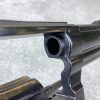aaaaa
Member
So, I have some cylinder end play on my S&W .41 Magnum. I measured it to about 0.004" but with a feeler gauge set that only went down to 0.008 and was in 0.002 increments up. Max was 0.012 and some places online say that is acceptable but at the upper end of acceptability for S&W.
One thing I saw online was that end play should be measured with empty cases in the cylinder to simulate the condition of a cartridge in place when firing. In so doing, it seems my end play may be less than stated above.
Tonight I obtained a better feeler gauge set that goes down to 0.0015 and will remeasure end play then post my findings here.
I also see apparently some have had different end play on different chambers in the cylinder. So I guess I should measure for each of the six bores. Too bad their is not a reference mark for the #1 bore or something.
Also, anyone please post your revolver's end play measurements and discussion.
One thing I saw online was that end play should be measured with empty cases in the cylinder to simulate the condition of a cartridge in place when firing. In so doing, it seems my end play may be less than stated above.
Tonight I obtained a better feeler gauge set that goes down to 0.0015 and will remeasure end play then post my findings here.
I also see apparently some have had different end play on different chambers in the cylinder. So I guess I should measure for each of the six bores. Too bad their is not a reference mark for the #1 bore or something.
Also, anyone please post your revolver's end play measurements and discussion.






